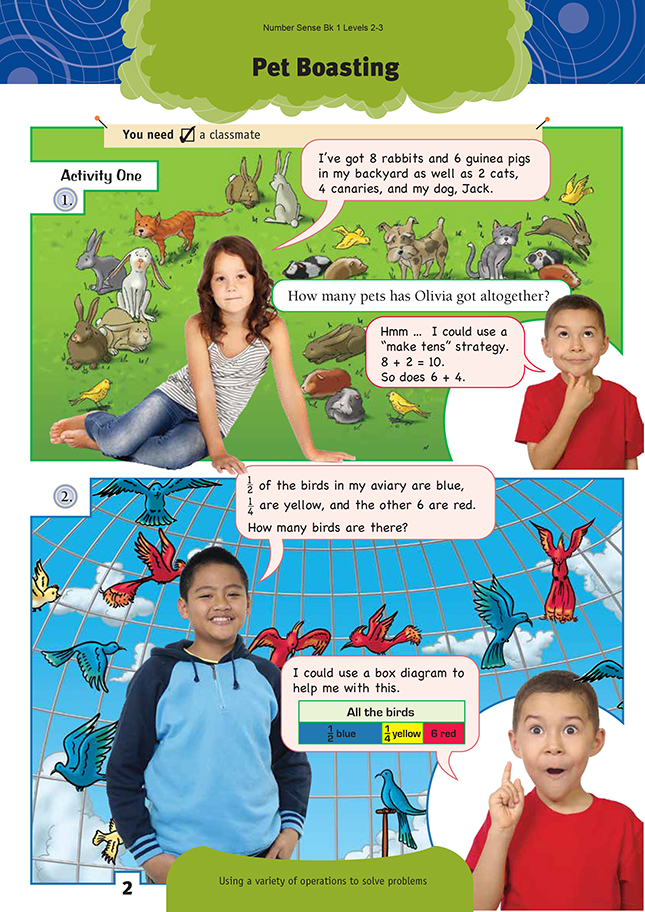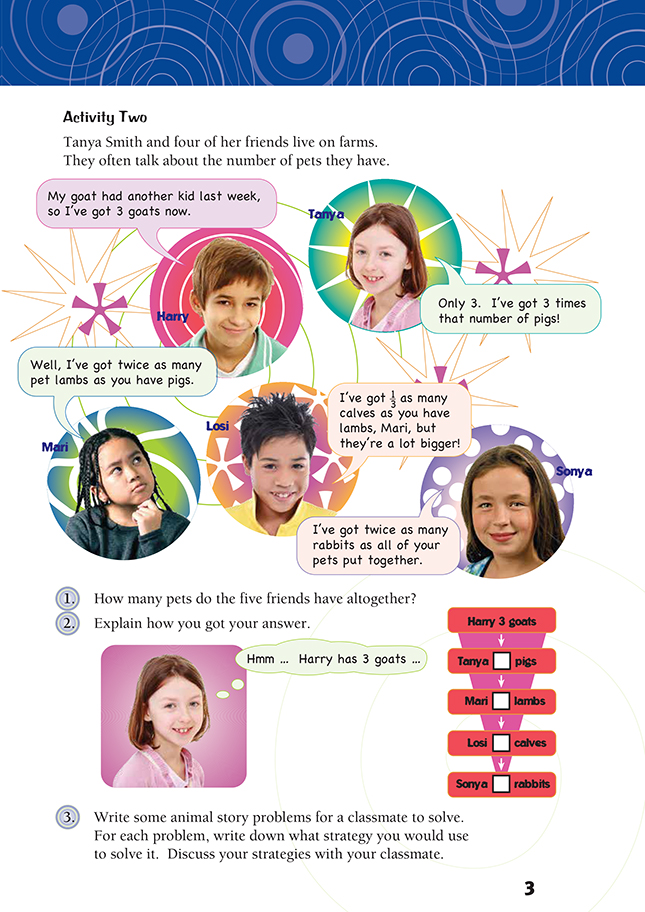This is a level 2 number activity from the Figure It Out series. It relates to Stage 5 of the Number Framework.
Click on the image to enlarge it. Click again to close. Download PDF (170 KB)
Find fractions of a number
Use a variety of operations to solve problems
Number Framework Links
Use these activities to:
• encourage transition from advanced counting strategies (stage 4) to early additive strategies (stage 5)
• help the students who are beginning to use early additive strategies (stage 5) to become confident at this stage in all three operational domains (addition and subtraction, multiplication and division, and proportions and ratios)
• help your students to consolidate and apply their knowledge of basic multiplication facts.
- FIO, Levels 2-3, Number Sense and Algebraic Thinking, Book One, Pet Boasting, pages 2-3
- A classmate
These activities expose students to a range of strategies, from simple addition to multiplication and division with single-digit factors and multiplication using simple unit fractions. To do these activities, the students need a basic understanding of multiplication and a knowledge of simple unit fractions.
Activity One
Question 2 challenges students to understand the relationship between halves, quarters, and the whole as a set.
If you are using materials and images, fraction pieces such as those in the Numeracy Project Material Master 4-19 (see Related Resources) or commercial fraction
pieces will be useful. Ask the students: How can we use this model or diagram to find the total number of birds?
Extension
As an extension using number properties, have the students record equations showing how many of each type of bird there are, that is, 1/2 x 24 = 12 blue birds and 1/4 x 24 = 6 yellow.
Ask them: What happens to a set if you multiply it by a half or a quarter? The students should notice that multiplying by a fraction makes the number smaller. Try to generalise this observation by exploring multiplying by fractions less than 1 and then by fractions greater than 1. This will help the students gain the critical understanding that multiplying by 1 is the point at which the quantity remains constant.
Activity Two
If you are using this activity for guided teaching, encourage the students to first make sure that they understand the problem. They must be able to find the relationships that connect the clues presented by the characters. Use small groups (discussed in the notes for “Wrapping up Wontons”) and have them present a report with diagrams that explain these connections. The students could then return to their groups to attempt the problems and report back on their strategies.
If you think materials will help the students, you could encourage the groups to act out the characters and use counters or beans to represent their pet. Animal strips like those in the Numeracy Project Material Master 5-2 could also be used or adapted to help solve the problems.
Answers to Activities
Activity One
1. 21. (Using a “make tens” strategy, this is 8 + 2 + 6 + 4 + 1.)
2. 24. ( 1/2 + 1/4 = 3/4 , so are red. 6 are red, so 6 are yellow and 12 are blue. 6 + 6 + 12 = 24)
Activity Two
1. 108
2. Strategies may vary. A possible strategy is:
Harry has 3 goats. Tanya has 3 x 3 or 3 + 3 + 3 = 9 pigs.
Mari has 9 x 2 or 9 + 9 = 18 lambs.
Losi has 18 ÷ 3 = 6 calves (3 x ? = 18).
3 + 9 + 18 + 6 = 36. (You could use a tens strategy here:
2 + 10 + 20 + 4 = 10 + 20 + 6
= 36.)
Sonya has 2 x 36 or 36 + 36 = 72 rabbits (30 + 30 = 60, 6 + 6 = 12, 60 + 12 = 72). The total number of pets is therefore 36 + 72 = 108. On a number line, the
addition could be shown like this:
3. Problems and strategies will vary.




